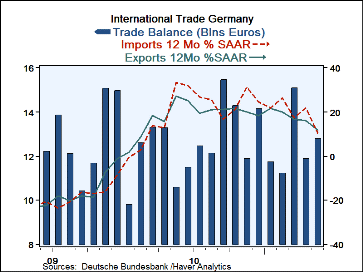 Global| Jul 08 2011
Global| Jul 08 2011German Trade Surplus Expands
Summary
German exports outpaced imports in May helping to boost the German surplus in May. But real export orders are turning lower. Exports orders fell by 5.8% and are declining at accelerating pace over the least three-months and six [...]
 German exports outpaced imports in May helping to boost the German surplus in May. But real export orders are turning lower.
Exports orders fell by 5.8% and are declining at accelerating pace over the least three-months and six months.
German exports outpaced imports in May helping to boost the German surplus in May. But real export orders are turning lower.
Exports orders fell by 5.8% and are declining at accelerating pace over the least three-months and six months.
The German economy has been showing signs of better domestic growth. As of this report exports are still outpacing imports. But the real side data as of May showed that real exports were starting to lag real import growth. In the May data on orders we can see that export orders are weakening for Germany even as the nominal trade flows hold to strong trends. So this month’s improvement in the trade picture may be somewhat of a last hurrah for German trade.
With growth weakening around Germany in the Zone it will be harder for German exports to maintain their growth. The slowing in China is another obstacle. Right now growth in Europe is challenged. Germany is a real bright spot, but not without its challenges. Expect these dynamics to play out on the trade flows in the months ahead.
| German Trade Trends for Goods | |||||||
|---|---|---|---|---|---|---|---|
| M/M% | % SAAR | ||||||
| May-11 | Apr-11 | 3Mo | 6Mo | 12M | 12MPrev | 2Yr Ago | |
| Balance* | € 12.81 | € 11.91 | € 13.28 | € 12.85 | € 12.92 | € 12.53 | € 11.84 |
| Nominal EXPORTS | |||||||
| Goods Exports | 4.3% | -5.6% | 24.3% | 16.7% | 11.8% | 41.9% | 9.0% |
| Capital gds | -4.9% | 33.3% | 9.2% | 15.5% | 21.0% | -27.8% | |
| Motor Vehicles | -1.0% | 26.0% | 13.3% | 18.3% | 44.7% | -42.9% | |
| Consumer Gds | -1.1% | 22.1% | 9.9% | 13.4% | 2.2% | -11.0% | |
| Nominal IMPORTS | |||||||
| Goods Imports | 3.7% | -2.5% | 18.7% | 16.9% | 10.4% | 47.2% | 14.3% |
| Capital goods | -2.5% | 7.9% | 7.6% | 15.6% | 6.4% | -11.2% | |
| Motor Vehicles | -4.7% | -5.7% | 4.0% | 20.7% | -0.2% | -16.2% | |
| Consumer goods | -3.5% | -6.5% | -0.1% | 10.5% | 5.4% | -10.1% | |
| ratio X:M | 116.7% | 116.1% | 115.4% | 121.0% | 122.0% | 118.8% | 125.6% |
| Real X -orders | -5.8% | 3.5% | -19.8% | -10.9% | 6.4% | 36.6% | -8.3% |
| Real Exports | -6.2% | 16.0% | 1.0% | 11.1% | 13.0% | -22.4% | |
| Real Imports | -1.9% | 7.9% | 3.8% | 12.2% | 7.4% | -12.0% | |
| Real Ratio X:M | 122.5% | 121.3% | 124.2% | 123.7% | 117.6% | 133.3% | |
| *Eur Blns; Mo or Period Average; Shaded Area Trends Lag One Mo | |||||||
Robert Brusca
AuthorMore in Author Profile »Robert A. Brusca is Chief Economist of Fact and Opinion Economics, a consulting firm he founded in Manhattan. He has been an economist on Wall Street for over 25 years. He has visited central banking and large institutional clients in over 30 countries in his career as an economist. Mr. Brusca was a Divisional Research Chief at the Federal Reserve Bank of NY (Chief of the International Financial markets Division), a Fed Watcher at Irving Trust and Chief Economist at Nikko Securities International. He is widely quoted and appears in various media. Mr. Brusca holds an MA and Ph.D. in economics from Michigan State University and a BA in Economics from the University of Michigan. His research pursues his strong interests in non aligned policy economics as well as international economics. FAO Economics’ research targets investors to assist them in making better investment decisions in stocks, bonds and in a variety of international assets. The company does not manage money and has no conflicts in giving economic advice.






